As important as an optical microscope system is to provide images with high resolution and contrast, digitizing the image seen through the eyepiece is equally important. This dramatically increases your ability to enhance features, extract information, and tell a meaningful story.
We have come a long way with respect to image capture, from photomicrography on a film to highly sensitive digital imaging that allows you to detect even single molecules. Digital imaging has allowed scientists to not only record their data, but also analyze it using new software technologies with artificial intelligence.
Digital cameras designed for life science have evolved considerably, and numerous technologies are available. From CCDs, to EMCCDs, to sCMOS, each technology has pros and cons and must be carefully chosen based on the application.
In this talk, Dr. Lin covers some critical facts about scientific digital cameras. He also discusses the evolution of these cameras, the solutions that Olympus offers, and how they are used in current advanced microscopy systems for various applications.
Presenter: Guo Lin, PhD
Manager, Product & Application, Olympus Signapore
Dr. Lin got his PhD back in 2010 in National University of Singapore working on biophysical research. From 2009 he joined Olympus as Technical and Application specialist taking care of laser based high end imaging system. In 2012, Lin decided to move back to China and taking a position with one of the leading scientific camera manufacturers Photometrics. There, he started as application specialist, later become regional sales manager and finally scientific sales manager for Asia Pacific. In 2021, Lin moved back to Singapore, joining Olympus Singapore as the manager for product and application. Lin has a long experience of various techniques on scientific digital imaging including various camera technologies.



